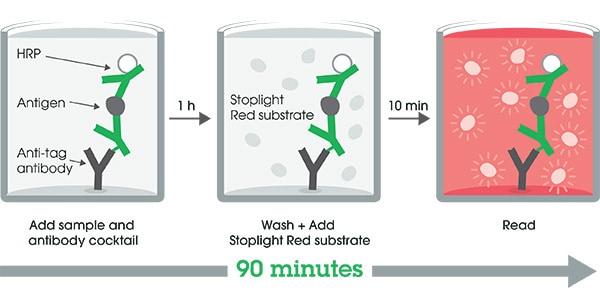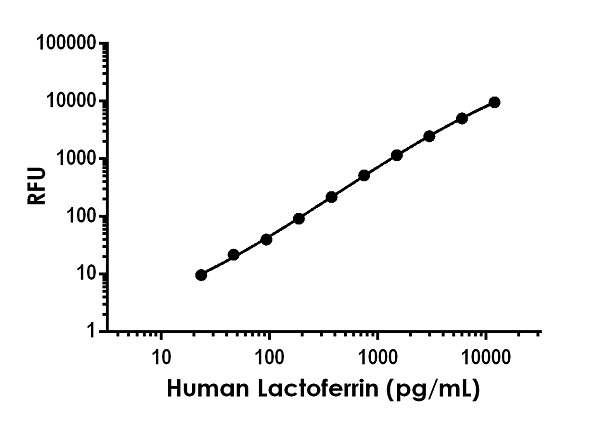Human Lactoferrin ELISA Kit, Fluorescent (ab229392)
Key features and details
- One-wash 90 minute protocol
- Sensitivity: 17.7 pg/ml
- Range: 19.5 pg/ml - 80000 pg/ml
- Sample type: Cell culture supernatant, Cit plasma, EDTA Plasma, Hep Plasma, Milk, Saliva, Serum, Urine
- Detection method: Fluorescent
- Assay type: Sandwich (quantitative)
- Reacts with: Human
Overview
-
Product name
Human Lactoferrin ELISA Kit, Fluorescent
See all Lactoferrin kits -
Detection method
Fluorescent -
Precision
Intra-assay Sample n Mean SD CV% Serum 8 5.1% Inter-assay Sample n Mean SD CV% Serum 3 5.4% -
Sample type
Cell culture supernatant, Saliva, Milk, Urine, Serum, Hep Plasma, EDTA Plasma, Cit plasma -
Assay type
Sandwich (quantitative) -
Sensitivity
17.7 pg/ml -
Range
19.5 pg/ml - 80000 pg/ml -
Recovery
Sample specific recovery Sample type Average % Range Saliva 120 113% - 126% Milk 109 99% - 118% Urine 99 99% - 100% Serum 102 100% - 105% Cell culture media 86 86% - 86% Hep Plasma 106 103% - 108% EDTA Plasma 108 105% - 110% Cit plasma 110 109% - 111% -
Assay time
1h 30m -
Assay duration
One step assay -
Species reactivity
Reacts with: Human -
Product overview
Lactoferrin in vitro CatchPoint SimpleStep ELISA (Enzyme-Linked Immunosorbent Assay) kit is designed for the quantitative measurement of Lactoferrin protein in human serum, plasma, milk, urine, saliva, and cell culture supernatants.
This CatchPoint SimpleStep ELISA kit has been optimized for Molecular Devices Microplate Readers. Click here for a list of recommended Microplate Readers.
If using a Molecular Devices’ plate reader supported by SoftMax® Pro software, a preconfigured protocol for these CatchPoint SimpleStep ELISA Kits is available with all the protocol and analysis settings at www.softmaxpro.org.The CatchPoint SimpleStep ELISA employs an affinity tag labeled capture antibody and a reporter conjugated detector antibody which immunocapture the sample analyte in solution. This entire complex (capture antibody/analyte/detector antibody) is in turn immobilized via immunoaffinity of an anti-tag antibody coating the well. To perform the assay, samples or standards are added to the wells, followed by the antibody mix. After incubation, the wells are washed to remove unbound material. CatchPoint HRP Development Solution containing the Stoplight Red Substrate is added. During incubation, the substrate is catalyzed by HRP generating a fluorescent product. Signal is generated proportionally to the amount of bound analyte and the intensity is measured in a fluorescence plater reader at 530/570/590 nm Excitation/Cutoff/Emission.
-
Notes
Transferrins are iron binding transport proteins which can bind two Fe3+ ions in association with the binding of an anion, usually bicarbonate. Lactoferrin is a member of the transferrin family and is a major iron-binding and multifunctional protein found in exocrine fluids such as breast milk and mucosal secretions. High levels of Lactoferrin are found in saliva and tears, intermediate levels in serum and plasma, and low levels in urine. The canonical sequence of Lactoferrin (known as isoform 1) is 710 amino acids in length and runs at 78.2 kDa. Isoform Delta-Lactoferrin (or DeltaLF) is missing amino acids 1 – 44 of the canonical sequence. Mouse and rat Lactoferrin are 71% and 62% identical to human Lactoferrin, respectively.
Lactoferrin possesses antibacterial, antiviral, anti-inflammatory, and immunoregulatory properties. The presence of Lactoferrin in neutrophils and the release of Lactoferrin during inflammation suggest that Lactoferrin is involved in phagocytic killing and immune responses. Additionally, Lactoferrin mediates bacteriostasis through its ability to sequester free iron and inhibit microbial growth. Lactoferrin also directs bactericidal properties leading to the release of lipopolysaccharides from the bacterial outer membrane. Furthermore, Lactoferrin may play a role in the regulation of bone growth because it has anabolic, differentiating, and anti-apoptotic effects on osteoblasts and can also inhibit osteoclastogenesis. Salivary Lactoferrin plays an important role in protecting the oral cavity against several oral pathogens including Streptococcus mutans. Additionally, increased levels of Lactoferrin in fecal samples is used as a marker of active inflammatory bowel disease (IBD).
-
Platform
Pre-coated microplate (12 x 8 well strips)
Properties
-
Storage instructions
Store at +4°C. Please refer to protocols. -
Components 1 x 96 tests 100X Stoplight Red Substrate 1 x 120µl 10X Human Lactoferrin Capture Antibody 1 x 600µl 10X Human Lactoferrin Detector Antibody 1 x 600µl 10X Wash Buffer PT (ab206977) 1 x 20ml 500X Hydrogen Peroxide (H2O2, 3%) 1 x 50µl Antibody Diluent 5BI 1 x 6ml Human Lactoferrin Lyophilized Purified Protein 2 vials Plate Seals 1 unit Sample Diluent NS (ab193972) 1 x 50ml SimpleStep Pre-Coated Black 96-Well Microplate 1 unit Stoplight Red Substrate Buffer 1 x 12ml -
Research areas
-
Function
Transferrins are iron binding transport proteins which can bind two Fe(3+) ions in association with the binding of an anion, usually bicarbonate.
Lactotransferrin has antimicrobial activity which depends on the extracellular cation concentration.
Lactoferroxins A, B and C have opioid antagonist activity. Lactoferroxin A shows preference for mu-receptors, while lactoferroxin B and C have somewhat higher degrees of preference for kappa-receptors than for mu-receptors.
The lactotransferrin transferrin-like domain 1 functions as a serine protease of the peptidase S60 family that cuts arginine rich regions. This function contributes to the antimicrobial activity. -
Sequence similarities
Belongs to the transferrin family.
Contains 2 transferrin-like domains. -
Cellular localization
Secreted. - Information by UniProt
-
Alternative names
- GIG12
- Growth inhibiting protein 12
- HLF2
see all -
Database links
- Entrez Gene: 4057 Human
- Omim: 150210 Human
- SwissProt: P02788 Human
- Unigene: 529517 Human
Images
-
SimpleStep ELISA technology allows the formation of the antibody-antigen complex in one single step, reducing assay time to 90 minutes. Add samples or standards and antibody mix to wells all at once, incubate, wash, and add your final substrate. See protocol for a detailed step-by-step guide.
-
Background-subtracted data values (mean +/- SD) are graphed.
-
Native human Lactoferrin protein was measured in serum diluted 1:64 and urine diluted 1:8 in Sample Diluent NS prior to a 2-fold dilution series in Sample Diluent NS. Purified human Lactoferrin protein was spiked into cell culture media diluted 1:20 prior to a fold dilution series in Sample Diluent NS. The interpolated dilution factor corrected values are graphed (mean +/- SD).
-
Native human Lactoferrin protein was measured in citrate plasma (1:128), EDTA plasma (1:150), and heparin plasma (1:64) diluted in a 2-fold dilution series in Sample Diluent NS. The interpolated dilution factor corrected values are graphed (mean +/- SD).
-
Ten individual healthy male donors and one pooled sample (n = 50) were evaluated for the presence of Lactoferrin in serum using this assay. Results were interpolated from the standard curve in Sample Diluent NS and corrected by sample dilution (1:75). In the 10 individual donors, the mean level of Lactoferrin is 350.3 ng/mL with a range of 106.2 – 627.7 ng/mL and a standard deviation of 159.4 ng/mL.
-
To learn more about the advantages of recombinant antibodies see here.



















